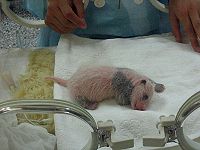Sichuan Giant Panda Sanctuaries
 From Nwe
From Nwe | Sichuan Giant Panda Sanctuaries* | |
|---|---|
| UNESCO World Heritage Site | |
 |
|
| State Party | |
| Type | Natural |
| Criteria | x |
| Reference | Retrieved June 24, 2008. 1213 |
| Region** | Asia-Pacific |
| Inscription history | |
| Inscription | 2006 (30th Session) |
| * Name as inscribed on World Heritage List. ** Region as classified by UNESCO. |
|
The Sichuan Giant Panda Sanctuaries (Simplified Chinese: 四川大熊猫栖息地; Traditional Chinese: 四川大熊貓棲息地; pinyin: Sìchuān Dàxióngmāo Qīxīdì), located in southwest Sichuan province of China, serves as the home to more than 30 percent of the world's highly endangered Giant Pandas. The sanctuary stands among the most important sites for the captive breeding of those pandas. Covering 9245 km², the Sinchuan Giant Panda Sanctuary encompasses seven nature reserves and nine scenic parks in the Qionglai and Jiajin Mountains. Along with the Giant Panda, the sanctuary provides refuge to other endangered species such as the Red Panda, the Snow Leopard, and the Clouded Leopard. Sichuan Giant Panda Sanctuary hosts one of the richest botanical sites outside of the tropical rain forests, home to between 5,000 and 6,000 species of flora. The area has been compared to the paleo-tropic forests of the Tertiary Era. In 2006, UNESCO designated the Sichuan Giant Panda Sanctuaries a World Heritage Site.
Approximately 1,600 Panda, a revered national symbol of China, live in the wild, most in Sichuan province. Approximately 30 percent of theGiant Panda population lives in Sichuan.[1] In addition to the natural habitat well-suited to support the Pandas, the Chinese government has established the China Conservation and Research Center for the Giant Panda at Wolong for breading Panda in captivity. A massive earthquake, with an epicenter only fifteen miles from the sanctuary, damaged the natural habitat Panda's need to survive. One estimate has stated that as much as 80 percent of the natural habitat vital for the Panda's survival has been damaged.[1] If that proves true, the fate of the Panda may lay in the balance. The Panda especially requires the bamboo grown in the region to survive.[2]
Nature Reserves
The Sichuan Giant Panda Sanctuaries contains seven nature reserves. They include:
- Wolong National Nature Reserve (Chinese: 卧龙自然保护区), the most well renown of the parks
- Fengtongzhai Nature Reserve (Chinese: 蜂桶寨自然保护区)
- Mt. Siguniang Nature Reserve (Chinese: 四姑娘山自然保护区)
- Laba River Nature Reserve (Chinese: 喇叭河自然保护区)
- Heishui River Nature Reserve (Chinese: 黑水河自然保护区)
- Jintang-Kongyu Nature Reserve (Chinese: 金汤—孔玉自然保护区)
- Caopo Nature Reserve (Chinese: 草坡自然保护区)
Wolong National Nature Reserve
Location: Coordinates:
Description
The People's Republic of China has decreed Wolong National Nature Reserve (Simplified Chinese: 卧龙自然保护区; Traditional Chinese: 臥龍自然保護區) located in Wenchuan County, Sichuan Province, a protected area. Established in 1963, the reserve covers an area of about 200,000 hectares, protecting over 4,000 recorded species in the reserve. Wolong National Nature Reserve houses more than 150 highly endangered giant pandas. In June 1980, the Chinese government established the China Conservation and Research Center for the Giant Panda at Wolong with the support of the World Wildlife Fund (WWF). As of 2007, researchers have conducted many breeding research on giant pandas and have successfully bred sixty six panda cubs.

Environmental Impact
A mountain stream runs through the Wolong Valley, in which the Reserve lies. Boulders and small, rounded stones, abound in the stream that has a high alkaline content with pH levels measured at 8.91. Plentiful sand and uncontrolled gravel mining have resulted in the poor water quality and extreme turbidity of the stream.[3] Dr. Jianguo Liu of Michigan State University, conducting research in 2001 research, concluded that the rate of degradation of the stream has increased since the creation of the Reserve. Liu's research team, using NASA's satellite images and records of population, concluded that due to tourism and the increase in local population has fostered an an unprecedented threat to the environment. "Tourists don't think they have an impact on panda habitat, but indirectly each visitor has some impact," Liu said. "We don't see ourselves as a destructive force, but we are."[3]
2008 Sichuan Earthquake
The region, including the Panda Research Center, was largely devastated on May 12, 2008, by a catastrophic earthquake, though the captive giant pandas have been reported safe.[4][5] Initially, officials lost contact with the reserve.[6] The People's Republic of China’s Foreign Ministry reported that a group of 31 British tourists visiting the Wolong panda reserve in the quake-hit area had returned safely and uninjured to the provincial capital. The well-being of an even greater number of pandas in the neighboring panda reserves remained unknown initially.
Five security guards at the reserve died during the earthquake.[7] Six pandas escaped from their damaged enclosures. By May 20, two pandas at the reserve had been found injured, while a search continued for another two adult pandas that went missing after the quake.[8] As of May 28, 2008, one panda remained missing.[9] Rescue teams later found the missing panda dead under the rubble of an enclosure.[10] Sadly, nine-year-old Mao Mao, a mother of five at the breeding center, had been discovered on Monday, June 9, 2008, her body crushed by a wall in her enclosure. Panda keepers and other workers placed her remains in a small wooden crate and buried her outside the breeding center.
Scenic Parks
The Sichuan Giant Panda Sanctuaries has nine scenic parks. They include Mount Qingcheng, which shares UNESCO's World Heritage Site designation with Dujiangyan Scenic Park.

- Mt. Qingcheng-Dujiangyan Scenic Park (Chinese: 青城山—都江堰风景名胜区)
- Mt. Tiantai Scenic Park (Chinese: 天台山风景名胜区)
- Mt. Siguniang Scenic Park (Chinese: 四姑娘山风景名胜区)
- Xiling Snow Mountain Scenic Park (Chinese: 西岭雪山风景名胜区)
- Mt. Jiguan-Jiulonggou Scenic Park (Chinese: 鸡冠山—九龙沟风景名胜区)
- Mt. Jiajin Scenic Park (Chinese: 夹金山风景名胜区)
- Miyaluo Scenic Park (Chinese: 米亚罗风景名胜区)
- Mt. Lingzhen-Mt. Daxue Scenic Park (Chinese: 灵鹫山—大雪峰风景名胜区)
- Mt. Erlang Scenic Park (Chinese: 二郎山风景名胜区)
Chengdu Research Base of Giant Panda Breeding

Chengdu Research Base of Giant Panda Breeding, or simply Chengdu Panda Base, located in Chengdu, Sichuan, People's Republic of China, serves as a non-profit research and breeding facility for Giant Pandas and other rare animals. Founded in 1987, the Chengdu Panda Base started with six giant pandas rescued from the wild. By 2007, the Center mid-wifed 110 panda births, and the captive panda population has grown to 62.[11] With the stated goal to "be a world-class research facility, conservation education center, and international educational tourism destination, the Chengdu Panda Base has earned international acclaim.
Partnerships

Chengdu Panda Base has partnered with numerous organizations to improving techniques for raising giant pandas in captivity. For example, its partnership with Zoo Atlanta helped the zoo secure the loan of two giant pandas.[12] To date, those two giant pandas, Yang Yang and Lun Lun, have given birth to one off-spring at the zoo.
Other research partners include:[13]
- Adventure World in Shirahama, Wakayama, Japan
- East Bay Zoological Society, Oakland, California, USA
- Liverpool University, UK
- National Institute of Health/National Cancer Institution, USA
- National Zoo, Washington, D.C., USA
- North of England Zoological Society, UK
- The Oakland China Wildlife Preservation Foundation, California, USA
- San Diego Zoo, California, USA
- University of Japan
See also
- Panda
Notes
- ↑ 1.0 1.1 MSNBC, "80 percent of China's panda habitat damaged." Retrieved June 24, 2008.
- ↑ YouTube: Panda eating bamboo at Chengdu Panda Base Retrieved June 24, 2008.
- ↑ 3.0 3.1 Wolong Nature Reserve Retrieved June 24, 2008.
- ↑ Pandas International Retrieved June 24, 2008.
- ↑ Pandas 'safe' at park after quake Retrieved June 24, 2008.
- ↑ Report: "Rare giant pandas at Chinese breeding center safe after quake," International Herald (May 13, 2008) Retrieved June 24, 2008.
- ↑ Melinda Liu, "Animal Instinct," China Earthquake (May 21, 2008) Newsweek Retrieved June 24, 2008.
- ↑ "Two pandas missing in China quake region," UPI (May 20, 2008) Retrieved June 24, 2008.
- ↑ "Panda reserve mulls moving after quake damage," Associated Press (May 29, 2008) CNN Retrieved June 24, 2008.
- ↑ Yangtze Yan, "One panda confirmed dead in China quake," (June 10, 2008-06-10), Window of China, Xinhua News Agency Retrieved June 24, 2008.
- ↑ About Chengdu Panda Base Retrieved June 24, 2008.
- ↑ Zoo Atlanta's Conservation Education Initiative in China Retrieved June 24, 2008.
- ↑ Research partners Retrieved June 24, 2008.
References
ISBN links support NWE through referral fees
- Bearer, Scott L. 2005. "The effects of forest harvesting on giant panda habitat use in Wolong Nature Reserve, China." Thesis (Ph. D.)—Michigan State University. Center for Systems Integration and Sustainability, Dept. of Fisheries and Wildlife, 2005. OCLC 78077970
- China giant panda garden: Wolong National Nature Reserve. 2001. Sichuan, China: Sichuan Nationality Publishing House. ISBN 9787540924768
- Hu, Jinchu, Tianzheng Liu, and Guangxin He. 1990. Xiong mao di feng zai / Giant pandas with graceful bearing. Zhengdu: Sizhuan ke xue zhi shu chu ban she chu ban fa xing. ISBN 9787536418059
- MacKinnon, John Ramsay. 1989. National conservation management plan for the giant panda and its habitat: Sichuan, Shaanxi and Gansu Provinces, the People's Republic of China: joint report of the Ministry of Forestry and WWF, World Wide Fund for Nature. Hong Kong: Printed by China Alliance Press. OCLC 27467554
- Schaller, George B. 1985. The Giant pandas of Wolong. Chicago: University of Chicago Press. ISBN 9780226736433
- Willis, Terri. 1995. Sichuan panda forests. Wonders of the world. Austin, Tex: Raintreee Steck-Vaughn. ISBN 9780811463676
External links
All links retrieved January 27, 2023.
- UNESCO description of the site
- Giant panda cubs at Wolong National Nature Reserve
|
|||||||
Credits
New World Encyclopedia writers and editors rewrote and completed the Wikipedia article in accordance with New World Encyclopedia standards. This article abides by terms of the Creative Commons CC-by-sa 3.0 License (CC-by-sa), which may be used and disseminated with proper attribution. Credit is due under the terms of this license that can reference both the New World Encyclopedia contributors and the selfless volunteer contributors of the Wikimedia Foundation. To cite this article click here for a list of acceptable citing formats.The history of earlier contributions by wikipedians is accessible to researchers here:
- Sichuan_Giant_Panda_Sanctuaries history
- Wolong_National_Nature_Reserve history
- Chengdu_Research_Base_of_Giant_Panda_Breeding history
The history of this article since it was imported to New World Encyclopedia:
- History of "Sichuan Giant Panda Sanctuaries"
Note: Some restrictions may apply to use of individual images which are separately licensed.
↧ Download as ZWI file | Last modified: 02/04/2023 08:01:14 | 42 views
☰ Source: https://www.newworldencyclopedia.org/entry/Sichuan_Giant_Panda_Sanctuaries | License: CC BY-SA 3.0
 ZWI signed:
ZWI signed:
 KSF
KSF